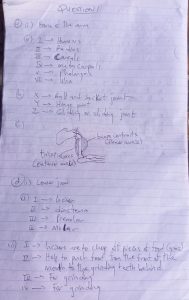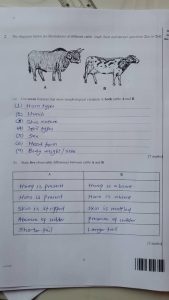
Number One


Number 2

Or
*WAEC GCE BIOLOGY PRACTICAL*
*NUMBER TWO*
(2a)
(i) Horn size and shape
(ii) Body size and build
(iii) Body coloration and patterns
(iii) Body coloration and patterns
(iv) Face shape and structure
(v) Muscle development
(vi) Tail length and shape
(viii) Udder size and shape
(2b)
in Tabular form
CATTLE A (Bull)
(i) Bulls are generally larger in size compared to cows.
(ii) Bulls tend to have a more muscular and robust physique.
(iii) Bulls have higher testosterone levels, which can influence their behavior and aggression.
(iv) Bulls are more likely to have large, curved horns compared to cows.
(v) Bulls have a deeper, more resonant voice compared to cows.
CATTLE B (Cow)
(i) Cows are generally smaller in size compared to bulls.
(ii) Cows have a more feminine and gentle appearance.
(iii) Cows have lower testosterone levels compared to bulls, leading to less aggressive behavior.
(iv) Cows have a developed udder for milk production.
(v) Cows have a higher-pitched voice compared to bulls.
(2ci) Genetic cross between cattle A (bull) and B (cow) for the patched skim trait:
(2ci)
Check the diagram below
(2cii)
incomplete dominance.
(2ciii)
Law of Incomplete Dominance.
(2civ)
1:2:1 (DD:Dd:dd)
(2d)
(i) Dominant: Cattle B (cow) “Dd”
(ii) Recessive: cattle A (bull) “Dd”.
(3a)
A- Cactus
B- Tainum Triangulans
(3b)
TABULATE:
HABITANT
A- Desert and Dry land
B- Savanna Garden, moist Damp Soil
UNDER A:
(i)Leaves are Reduced to spine to reduce to water loss
(ii)Thick Stem to consewe water.
UNDER B:
(i)Shallow Root
(ii)Has no elaborate water storage
(3c)
TABULATE
A:
(i)Leaf of A are reduce to spine
(ii)Presence of Sunkon stomata
(iii)Absence of flowers
(iv)Absence of wide lamina
B:
(i)Leaves of B are wider not reduced to spines
(ii)Absence of Sunkon Stomata
(iii)Presence of Flowers
(iv)Presence of wide lamina on the leaves
(3di)
(PICK ANY TWO)
(i)Leaves are reduced to spines
(ii)Thick waxy cuticle is present
(iii)Thick stem is present
(3dii)
(i)Provides vitamins and minerals that boosts animal immunity
(ii)Provides antioxidant in animal diet and acts as mild laxatives
(iii)Provides fibre and energy to animals (carbohydrates)
(3e)
(i)Kingdom – Plantae
(ii)Division – Tracheophyta
(iii)Class – Angiosperm
(3fi)
Magnification = image length/ actual length
= 10cm/200cm
= 0.05
(3fii)
Liliopsida
(3fiii)
(i) Parallel-veined leaves
(ii) Scattered vascular bundles in the stem
(iii) Seeds with a single cotyledon
(3fiv)
Distichous

Leave a Reply